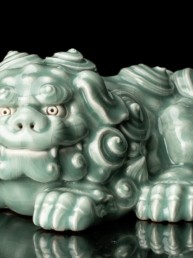Are you a private or institutional collector of the works by a specific artist or from a specific era? Are you looking for works by artists new on the scene or possibly from a certain genre of Japanese art? Here in Kyoto we have access to a network of local galleries, private auction houses, and personal contacts to help you find the types of art pieces you may be searching for. Please sign our guest book and let us know what you would like to see in the gallery or contact us directly with specific requests.
Being made from natural materials such as wood, lacquer, paper, dyes, silk, and clay—if not properly cared for Japanese antique artworks have a tendency to deteriorate over time. There is however, a fine line separating age-related damage from that elusive category that is often referred to as “aji” in Japanese—the elegance bestowed upon an object through the process of graceful aging. Ultimately it is a mater of differing tastes and opinions; those who would like an artwork to look well-cared for and as pristine as possible, and those who would like to see the processes of time at work, and for an artwork to show its age—thus providing us with added assurance and clues regarding its provenance. With both of these positions being valid, it is really up to the owner of an art piece to decide how they feel about the appearance based on this understanding. For those who would like to mend or replace worn fabrics, remove discoloration from old scrolls, repair chips or cracks in ceramic pieces, or possibly those looking for detailed restorations of faded paintings, we either offer these services or can put you in touch with those who do.
The seasoned collector of Japanese antique art will tell you that it is not uncommon to come across copies and reproductions being passed off as authentic works. Many of the great artists that are remembered today were heavily copied, either in their own time or by later generations. To ensure that important cultural works are reliably identified and preserved, the Japanese have worked out a complex system for separating imitations from authentic works. This system usually relies either on the opinion of a body of experts, a priest from a temple the artist belonged to–painstakingly trained to recognize authentic works, or on a decedent of the artist who is intimately acquainted with all of the artist signatures, seals, and the various stylistic clues which help to assure that a work is genuine. If you currently own a work of Japanese art that you would like authenticated, please let us know and we can assist with this process.
If you are planning to spend a few days in Kyoto and would like a knowledgable guide and translator to show you around the various galleries, museums, studios, and workshops–feel free to contact us for details and daily rates.
We are always very supportive of projects that incorporate traditional craftsmanship and encourage collaboration between local artisans and those looking to integrate these age-old techniques into their own creations. Although still alive and active, traditional Japanese crafts are in danger of slowly fading away without renewed appreciation and interest—both domestically and from admirers of Japanese art abroad. Below are examples of the types of artisans we often work with:
Woodworkers Ribbon makers Kintsugi craftsmen (gold repair) Kimono weavers Lacquer artists Metalworkers Ceramicists Painters Tatami mat craftsmen Bamboo artists Calligraphers Traditional landscapers Traditional carpenters














































































